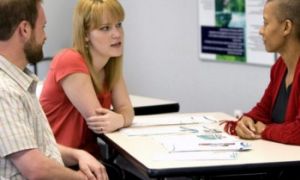In early childhood, positive relationships with teachers are extremely important for intellectual, social and emotional development. Indeed research shows that secure attachments formed in early years do not just prepare the foundations for positive relationships in adulthood but predict positive life outcomes as well. The following article provides strategies on how Educators can build relationships with children.
Listen Actively
Active Listening involves lending your undivided attention to someone who is speaking to you, unlike passive listening which is merely hearing the speaker without trying to understand what is being said. When a child is saying something to you, give them your complete attention. Focus on what they are saying, both with their words as well as with voice inflections, rate of speech and body language. For example, when a child is explaining a picture they have drawn, observe their gestures and facial expressions as a clue for how interested they were in the task.
Engage With Them
Maintain eye contact with the child and get on their level for face-to-face interactions. Interact nonverbally with your learners using small gestures or verbal affirmations, such as nodding your head or offering very brief comments such as “I see”. Vocalizations such as “uh-uh” or “hmm-hmm” are other effective ways of showing that you care about what they are thinking or feeling. Use a pleasant, calm voice and simple language while avoiding exaggerated gestures or dramatic expressions which could confuse the child as to the import of the words said or take away the focus from them to you.
Offer Positive Contact
Use affectionate behaviour with children to build positive relationships. Examples include smiling at them warmly, praising sincerely and welcoming them lovingly when they arrive in the classroom. Respectful and appropriate physical contact like hugging, holding hands and patting on the back are other ways of nurturing positive attachment between educators and children.
Use Age-appropriate Strategies
While building nurturing relationships with children, it is important to use strategies that are developmentally appropriate. strategies that take into consideration children’s differing needs, interests, styles, and abilities. For example, when responding to crying infants or toddlers, teachers usually have affectionate physical contact like hugging and holding young children in their laps. However distressed preschool children might feel more reassured when teachers offer them opportunities to express their feelings before responding with soothing words and gestures. Likewise, positive relationship-building strategies will have to take into account the needs, preferences and communication styles of different children. So reassuring words and vocalizations may be more beneficial to soothe an auditory learner than a tactile learner who may respond better to hugs or being held.
Take The Child’s Lead
Learner-led activities and lessons are among the most effective means of building classroom rapport and motivation. Give children ample opportunities to express their interests and curiosity. Look for teaching moments in free play or discussions to facilitate their understanding of curricula concepts and skills. The other advantage of learner-led and driven lessons is that they increase task compliance since activities are aligned with their interests.
Implement Positive Guidance Measures
In order to build trusting relationships with educators, children need to feel emotionally and physically secure in the classroom. To minimize the occurrence of disruptive and negative behaviour by using positive guidance strategies like positive guidance techniques through modelling appropriate behaviour, redirecting children to more acceptable activities, explaining classroom expectations, setting clear limits and reinforcing desirable behaviours among others.
Further Reading
Building Relationships with Families and Co-Workers - The following provides helpful tips to help build positive relationships with families and work colleagues.
How To Achieve Quality Area 5 - The following is a list of outcomes under each element within QA5, that can help services identify if they are achieving Quality Area 5. It also includes documentation to support each element. This list can be used as a guide for Self-Assessment purposes and the development of the Quality Improvement Plan.
Positive Interactions With Children - The following article provides information on What Are Positive Interactions, Developing Positive Interactions, Strategies and more.
Reference
Building Positive Teacher-Child Relationships. Centre On The Social and Emotional Foundation For Early Learning







 As an Educator in Australia, your pay rate falls under the Children’s Services Award 2010. This award states the minimum amount that an employer can
As an Educator in Australia, your pay rate falls under the Children’s Services Award 2010. This award states the minimum amount that an employer can When working as a qualified Early Childhood Teacher (with a university degree) within a service, your rate of pay will come from the Educational Services
When working as a qualified Early Childhood Teacher (with a university degree) within a service, your rate of pay will come from the Educational Services When working as a Diploma Qualified Educator your pay rate is from the Children's Services Award 2010. This Award states your minimum rate of pay
When working as a Diploma Qualified Educator your pay rate is from the Children's Services Award 2010. This Award states your minimum rate of pay When working as a Cert 3 Qualified Educator, your pay rate is from the Children's Services Award 2010. This Award states your minimum rate of
When working as a Cert 3 Qualified Educator, your pay rate is from the Children's Services Award 2010. This Award states your minimum rate of Educational Leaders play a crucial role in their early childhood service by ensuring that the educational program aligns with best practices and supports the holistic
Educational Leaders play a crucial role in their early childhood service by ensuring that the educational program aligns with best practices and supports the holistic In early childhood education and care, ratios are more than a technicality—they are a frontline safeguard. Every child deserves responsive supervision, emotional connection, and developmental
In early childhood education and care, ratios are more than a technicality—they are a frontline safeguard. Every child deserves responsive supervision, emotional connection, and developmental Here’s a comprehensive Mobile Phone and Smart Watch Policy tailored for early childhood education and care (ECEC) services in Australia, aligned with the latest 2025
Here’s a comprehensive Mobile Phone and Smart Watch Policy tailored for early childhood education and care (ECEC) services in Australia, aligned with the latest 2025 With the new national child safety reforms kicking in on 1 September 2025, early childhood services like yours have a real opportunity to lead the
With the new national child safety reforms kicking in on 1 September 2025, early childhood services like yours have a real opportunity to lead the The Sea of Fish Challenge is a national initiative that invites children, educators, families, and communities to create and display fish artworks as a symbol
The Sea of Fish Challenge is a national initiative that invites children, educators, families, and communities to create and display fish artworks as a symbol Across the early childhood education and care sector, educators are sounding the alarm: current staffing ratios are insufficient to deliver safe, meaningful, and developmentally appropriate
Across the early childhood education and care sector, educators are sounding the alarm: current staffing ratios are insufficient to deliver safe, meaningful, and developmentally appropriate


